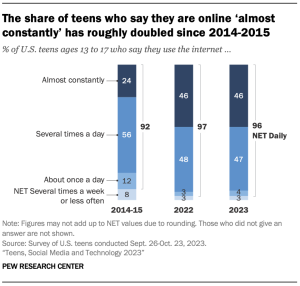As technology advances, cyber crimes have become increasingly prevalent in society.
The internet connects people from various demographics, regardless of race, age, or gender. While this connectivity has revolutionized communication, it has also contributed to a problematic surge in online child exploitation. In 2023 alone, the CyberTipline, created by the National Center for Missing and Exploited Children (NCMEC), received 36.2 million reports of child sexual exploitation online.
“It’s dangerous,” said Shelley Bustamante, the mental health specialist at Carlmont. “There are predators out there; we had a student who thought she was speaking to somebody who was a 16-year-old boy, and he turned out to be a 68-year-old man.”
A recent case highlights the importance of online safety: Luis Alberto Salas, a 35-year-old man from Watsonville, California, was arrested for charges including contacting a minor with the intent for sex, kidnapping, and false imprisonment, according to a Facebook post from the Santa Cruz County Sheriff’s Office.
“Detectives are continuing to interview witnesses and go through evidence that has been collected to build a strong case,” said Ashley Keehn, the public information officer for the Santa Cruz County Sheriff’s Office.
According to Keehn, the District Attorney’s Office has filed a number of additional charges against Salas since his arrest.
The seven victims of Salas have remained anonymous, with ages ranging from as young as 13 to 16, according to the Santa Cruz Sentinel. Authorities primarily detected Salas’s criminal activity in Santa Cruz, Capitola, Scotts Valley, and unincorporated areas of Santa Cruz County.
According to KRON4 News, Salas used Snapchat, a popular social media app among teens, to lure victims into meeting him with handles such as “Penjaminpookie,” “Cookies_squad,” and “LusciousLouie.” Authorities believe that Salas primarily used Snapchat to distribute illegal substances such as drugs and alcohol to minors in return for sex acts.
Salas is currently being held without bail, and the Santa Cruz County Sheriff’s Office has strongly encouraged all parents and guardians to discuss the importance of staying safe while navigating online platforms.
“While we don’t track the exact number of online exploitation cases, the department has seen an increase in the past decade or so with the rise in technology usage,” Keehn said. “We think it is extremely important for parents or guardians to have open communication with their children about how to use social media responsibly.”
Snapchat allows people to send and receive photos and videos that disappear over time, giving users a sense of perceived privacy. A study from the Pew Research Center found that 60% of teens aged 13-17 use Snapchat, emphasizing its popularity among adolescents and its potential as a tool for online predators.
With millions of teens navigating online platforms such as Snapchat, the line between harmless fun and potential danger becomes blurred. What starts as a casual, friendly social media interaction can quickly take a darker turn. Isabella Serling is a sophomore at The Bay School of San Francisco who regularly uses Snapchat to communicate with her friends.
“A lot of guys like to add me on Snapchat,” Serling said. “I’ll add them back, and they’ll start asking questions like ‘what do you look like?’ or just straight up asking for nudes.”
Serling’s experience highlights the dangers and discomforts of an online presence. However, it is far from uncommon; many teens face similar pressures online, where casual interactions can escalate into uncomfortable situations.
The COVID-19 pandemic played a large part in amplifying social media’s influence on daily life. Isolated at home, many teens turned to social media to make new friends while quarantined at home.
“Around the time of the pandemic, online games were a big thing,” said Suri Taherian, a sophomore at Carlmont. “There was this one person I used to be friends with in 2021 who was nice at first but started to send some indecent images and messages.”
The pandemic’s impact on social media’s role in day-to-day life is still prevalent; many teens still engage in and seek out online friendships. In addition, a study from the Pew Research Center found that the amount of teens who report being online ‘almost constantly’ has doubled since 2014-2015, further emphasizing the importance of being aware of online safety.
“I just blocked all communication with them,” Taherian said.
She emphasized that she stood her ground and established boundaries whenever she felt uncomfortable or uneasy. She would block people and move on if they ever violated those boundaries.
Many online platforms have implemented new policies and features to help protect teens online. With Instagram’s latest addition of teen accounts, parents can supervise what kind of content their child is exposed to online. Adults over 18 are also restricted from starting private chats with teen accounts unless they are connected through Instagram or Messenger.
However, many social media platforms still struggle to regulate and monitor the relationships established on the platform.
“Private messages are pretty difficult to monitor because lots of people are concerned about their messages being encrypted,” Taherian said. “People nowadays really want their messages to be secure so that they are able to maintain their sense of perceived privacy, which is something that lots of platforms compete in. If they want to regulate harassment in DMs, they’re going to have to let go of that encryption and start monitoring all the messages.”
Serling, on the other hand, suggested a different approach.
“I feel like a lot of the time, if you can see that an account is getting blocked by a lot of people, then their account should be deleted, and they shouldn’t be allowed to have that specific app,” Serling said.
Parents and guardians also play a crucial role in ensuring children and teens stay safe online. Florance Gee is the mother of a Carlmont student who actively supervises her child’s online activities.
“I use the Screen Time feature to limit the amount of time my daughter spends on certain apps, like games or social media,” Gee said.
Like many other parents, Gee worries that strangers online might try to take advantage of her child to access personal information or money. Gee also added that she thought schools could provide more education regarding online safety so teens can ignore solicitation and report suspicious activity online.
Echoing this sentiment, Bustamante emphasizes the importance of trust between a parent and child when discussing online safety.
“I think when kids are young, it would be great for them to share their password with their parents. I don’t think the parent needs to be checking it out every day and night, but from time to time, they should,” Bustamante said.
Bustamante added that online safety is a topic that the Students Offering Support (SOS) program at Carlmont would like to discuss in more detail.
“Kids come into high school, and they don’t get enough information about what could really get them into trouble,” Bustamante said.
If you or someone you know is a victim of online exploitation, please do not hesitate to utilize the resources below:
https://www.missingkids.org/gethelpnow/support/teamhope
Additionally, resources for parents or guardians to educate their children about online safety are also provided below:
https://www.svicac.org/vigilant-parent-initiative
https://www.smartcyberchoices.org/
https://consumer.ftc.gov/identity-theft-and-online-security/protecting-kids-online























